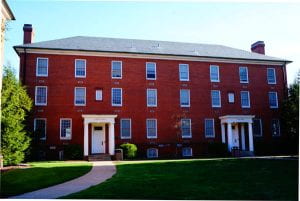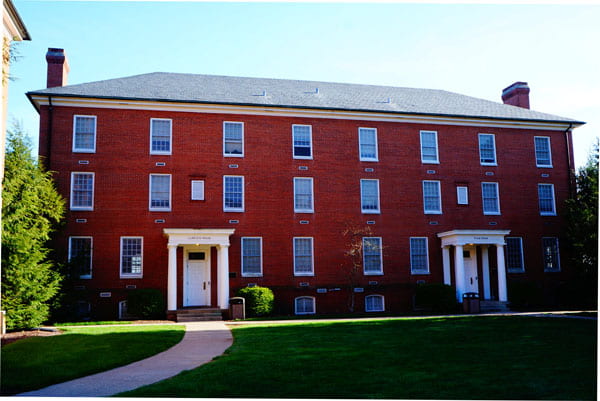BY MORGAN KING – STAFF WRITER
For years now, Centre College used Nevin Hall as a first-year men’s residence hall, but soon that is all set to change. Beginning next fall, all first-year residences halls will be coeducational.
This new model comes after many months of exploratory questions on what to do about the growing size of incoming classes at Centre. The Class of 2018 set records as the largest class in Centre’s history, and finding a bed for 387 students is not the easiest task to undertake, a problem Director of Student Life and Housing Ann Young understands all too well.
“It is getting harder, in my job, to make it all work. Always finding empty beds for women, but maybe not men, and vice versa. It is a huge jigsaw puzzle,” Young said.
The new system will be set up like the current ‘catch-all’ residence hall, Acheson-Caldwell, where men currently reside on the third floor and women on the second. At the beginning of next year, gender separation by floor will be the norm in the rest of the first-year residence halls—and the top floors of LaMotte House and Tyler House. With the new system, there will be no strict guidelines on where to put each first-year on campus. Instead, the model allows flexibility with housing placements and relieves the cramped feeling that many Centre students felt for the past few years.
The change to co-ed first-year residence halls might be new to Centre, but this model is in place for many schools in the Associated Colleges of the South, of which Centre is a part.
“I think we are certainly, if anything, behind the times when it comes to this, compared to other schools, like some of our benchmark schools, and our aspirant schools. As we have gradually become more co-ed, we have had nothing but positive results,” Young said.
It is true that residence life is not currently designed to facilitate a co-ed lifestyle in the case of first-years. Upon their arrival to campus, close bonds are formed to those in proximity to themselves, such as those on the same hall and in their residence hall. It is difficult to make connections outside of Orientation groups between those that live elsewhere on campus given the separation between residence halls, which may be a contributing factor to the relations between men and women seen in Centre’s student life. Director of Residence Life Jacob Raderer agrees that changing the current model is needed, not just from a housing standpoint, but a social one as well.
“One of the things this is going to allow us to do is do away with the geographic segregation of the first-year class. The genders are segregated. This will allow us to mix that a little bit, and we are going to see multiple outcomes from this experience, such as how the first-year class interacts with one another. It will not be right from the beginning of school men versus women. It is the first-year community living together,” Raderer said.

The deciding factor, according to Raderer, that finally prompted the change was the complete update of Nevin Hall’s bathrooms with renovations set to start this summer. This update quells the biggest concern for the new change — the crisis of having women now using a bathroom only used by men for the last 50 years.
For those that give Nevin Hall the affectionate nickname of ’Nasty Nevin’ Raderer believes that the stigma is unjustified.
“What I have heard from students and [Resident Assistant’s] is the question ’You are putting women in Nevin? EW’ Again, the bathrooms are going to be redone and with that will come deep cleaning, as done in all residences every summer,” Raderer said.
Other than the renovation to Nevin Hall, there are no other changes accompanying the new model. The visitation policy stipulating that no one of the opposing gender will be on a first-year hall for the first three weeks of the fall semester will still be in effect. The visitation policy is currently this way with the co-ed first-year residence hall, Acheson-Caldwell House.
“[For Acheson-Caldwell House] we have been successful with having first-year men on the third floor and first-year women on the second. We have not had any problems with the visitation at all. Separating it by floor versus an all co-ed residence hall allows us to do that. When you have a floor of women for the first three weeks, it is pretty evident if there is a male on the floor. The policy, and the enforcement of the policy, will remain as is,” Raderer said.
While some students are in favor of the change, others have a few concerns. The effectiveness of the visitation policy as an added “stress” during the first year of college and a loss of tradition seem to be the most common concerns. “People talk about Nevin being a ‘rite of passage’ for the first-year men. With co-ed residences, that rite will change,” Junior Cammie Jo Bolin said.
Students are not the only ones thinking of the tradition lost with the implementation of first-year co-ed residence halls. Those who have only known Nevin Hall and Yerkes House as first year residence halls for men and women respectively may be startled by the change.
“Alumni may have a little concern, or even parents who have had other children come here. But the benefits of this, in terms of flexibility with numbers and positive behavioral and social outcomes, in terms of male/female interactions and gender relations on campus, are all things we have talked about and what we see coming out of this,” Raderer said.
While members of Centre’s student population are surprised to see a change in what seems like an old tradition, they are generally excited to see the changes ahead, like first-year Kirby Fitzpatrick.
“It will be an interesting change to campus. It is nice to have a quieter spot on campus, but this is something a lot of colleges are doing. I appreciate Centre being aware of this change and modifying their own policy,”
It is clear, given Centre’s growing numbers, that a change in the housing model was needed. Now, incoming students at Centre next fall will be able to establish a new tradition and blaze a trail for generations forward.
